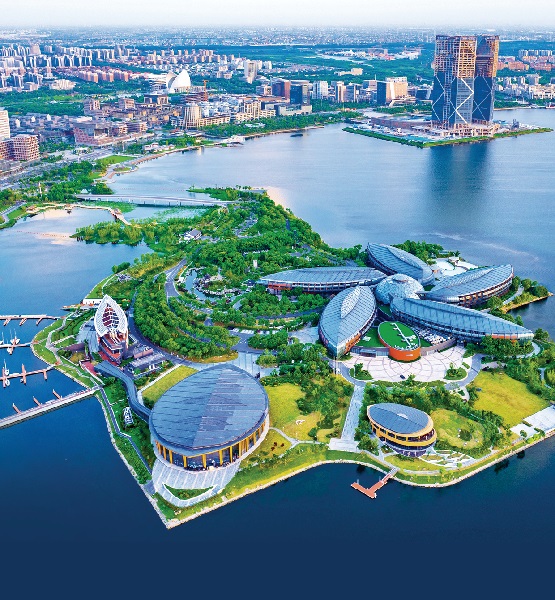
The closely packed buildings on the bank of Dishui Lake in the Lingang new area of the China (Shanghai) Pilot Free Trade Zone are a step towards Shanghai’s transformation into a modern city of the future.
Thirty-four years ago, the tallest building in Shanghai’s Pudong area was the Fire Watchtower on Dongchang Road. Its height was merely 24 meters. It was matched by Pudong’s GDP, which was a little over RMB six billion. Today, the tallest building in Pudong is the Shanghai Tower at a whopping height of 632 meters, and the skyline is full of majestic skyscrapers, such as the Oriental Pearl Tower and Shanghai World Financial Center. Proportionately, the district’s GDP has rocketed to over RMB 1.67 trillion. Reform and opening-up, started in 1978, has brought new vitality and prosperity, along with dramatic changes.
While Shanghai is the frontier of China’s reform and opening-up, the Pudong New Area in eastern Shanghai is a pioneer mandated with piloting new systems and exploring new development paths. To boost trade, China’s first bonded area was established here. It then became China’s first pilot free trade zone. The once muddy land by the Huangpu, Shanghai’s mother river, has metamorphosed into the lustrous “Oriental Pearl.”
Since the 18th National Congress of the Communist Party of China (CPC) in 2012, President Xi Jinping, also general secretary of the CPC Central Committee, inspected Shanghai six times, directing the megacity to “spearhead the reform and opening-up and pioneer innovative development.” Last year, he stressed that Shanghai should comprehensively deepen reform and opening-up from a higher starting point and enhance development momentum and competitiveness.
Earlier this year, the General Office of the CPC Central Committee and the General Office of the State Council issued the Implementation Plan for the Pilot Comprehensive Reform of Pudong New Area of Shanghai (2023-2027), highlighting “originality” and “leading role” of reform policies.
In 2020, Pudong, with only 1/8,000th of China’s land area, created 1/80th of the national GDP, becoming a miracle of China’s reform, opening-up, and economic development. By 2023, this ratio had reached a new high of 1/75th.

A foreigner practises the “Fitness Dragon” dance in Pudong, Shanghai, watched by appreciative onlookers who give him a thumbs-up, March 29, 2024.
The Starting Point
In 1990, the Pudong Development Office was established, marking the starting point of the area’s reform and opening-up. Two shelves and a long table formed the three-square-meter reception area. But though small, it played an important role in providing consultation and guidance to the nearly 100 visitors it received daily. For the many foreign investors who came, the reception was their first impression of Pudong’s business environment. Today, the office has become the Pudong Development Exhibition Hall.
In 2017, Pudong launched a “one-stop online service” for market access registration. This meant newly registered enterprises could get an appointment and have their papers processed the same day. From multiple trips to one trip and then to none, the one-stop online service works with lightning speed. By 2018, the approval procedure for all the 327 items that needed district-level approval had been moved online, requiring no face-to-face meetings.
Licenses were issued before permits and one certificate did the function of many. Such measures lowered the market entry threshold and institutional transaction costs, and the new terms born from Pudong’s deepening reform became buzzwords.
In 2020, Pudong took the lead nationwide to pilot artificial intelligence (AI)-assisted approval. By using AI-based information recognition, core algorithms, and knowledge graphs, it built an “approval brain,” enabling enterprises to apply without having to submit any materials. This AI-assisted approval system covers all enterprise-related approval items, with the entire process taking only 10 minutes.
The “business permit” is a high-frequency item in administrative approval services. The streamlined but faster approval process reflects the government’s transformation from a “manager” to a “service provider.”
In July 2019, the Pudong New Area implemented the “one integrated license” reform, integrating multiple licenses into one comprehensive license, reducing the approval processing time by nearly 90 percent and application materials by nearly 70 percent.
“After the one-integrated-license reform, I only need to submit the application online, and after the preliminary review, I submit one document,” said a brand manager who applied for licenses for multiple stores. “Then I submit the materials on site, and get the industry comprehensive license, greatly saving time.”
These pioneering reform measures have stimulated Shanghai’s economic vitality and created a world-class business environment.

At the Metaverse experience zone of the 2024 World AI Conference in Pudong, Shanghai, visitors take part in HADO, an e-sport using augmented reality, showcased by meleap China, on July 5, 2024.
Openness, the Defining Characteristic
“Openness” is Pudong’s mission and greatest characteristic.
It has created a model of institutional opening-up. The China (Shanghai) Pilot Free Trade Zone follows high-standard international economic and trade rules, such as those regulating the Comprehensive and Progressive Agreement for Trans-Pacific Partnership and the Digital Economy Partnership Agreement.
Pudong has been working to build an enabling business ecosystem for innovation. It launched a public service platform that bids for the best candidates for scientific and technological innovation. Focusing on creating new quality productive forces and promoting a modern industrial system, Pudong has optimized its industrial and spatial layouts and service system, eyeing for the development of the entire industrial chains. To provide financial support for technological innovation, it has established a special fund.
Attracting high-level talent is another priority. Its service for world top-notch talent can be experienced from the moment people arrive in the Pudong International Airport. 
ZHANG HAIYING & BAO XIAOLAN are reporters with China Development and Reform News.
Timeline of Pudong’s Deepened Reform
1990: The CPC Central Committee makes the strategic decision to develop and open up Pudong, sending out the message that China would continue to reform and open wider.
2005: The State Council approves Pudong as a pilot for the country's reforms.
2013: The China (Shanghai) Pilot Free Trade Zone is launched.
2019: The Lingang section of the China (Shanghai) Pilot Free Trade Zone is unveiled.
2021: The CPC Central Committee and the State Council issue Opinions on Supporting the Pudong New Area in Building Itself into a Leading Area for Socialist Modernization through High-standard Reform and Opening-up. Both Shanghai and the Pudong New Area boldly experiment and independently explore reforms, leading the country's efforts.
2024: The General Office of the CPC Central Committee and the General Office of the State Council issue the Implementation Plan for the Pilot Comprehensive Reform of Pudong New Area of Shanghai (2023-2027), giving Pudong greater autonomy in reforms in key areas and critical links.